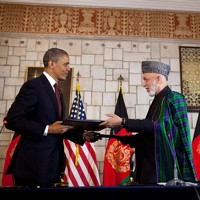On May 2, the United States and Afghanistan signed a new Strategic Partnership Agreement after months of negotiations. In the accord, the United States pledged to support social and economic development, provide security assistance and promote regional cooperation for 10 years beyond the planned 2014 withdrawal date for all U.S. combat troops from Afghanistan. Under the terms of the agreement, the United States will not seek permanent military bases in the country, but can receive access to Afghan facilities. In return, the Afghanistan government committed to strengthen accountability, transparency, the rule of law and human rights for all Afghans, male and female.
Although the agreement is not legally binding, securing it yields advantages to both parties. It reassures the government of Afghan President Hamid Karzai, as well as its successors and regional allies, that they will not be abandoned by the West. The deal also provides Kabul with leverage in dealing with the Afghan Taliban, Iran and Pakistan by weakening any perception that the United States and its NATO coalition allies will simply wash their hands of Afghanistan after pulling their troops out of the country.
Nonetheless, the agreement left several questions unresolved, including how many U.S. troops would remain after 2014 and what missions they can undertake. These issues will be specified later in a separate and more detailed security agreement that is still under negotiation. Any U.S. soldiers deployed to Afghanistan after 2014 will most likely be military trainers and special operations forces, with the latter focused on capturing or killing terrorists in Afghanistan or in neighboring countries.

